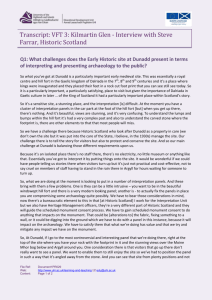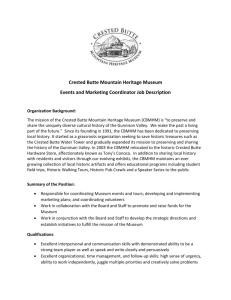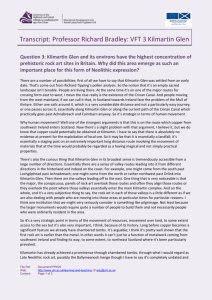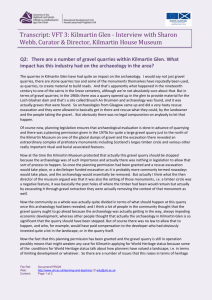Transcript: VFT 3: Kilmartin Glen
advertisement
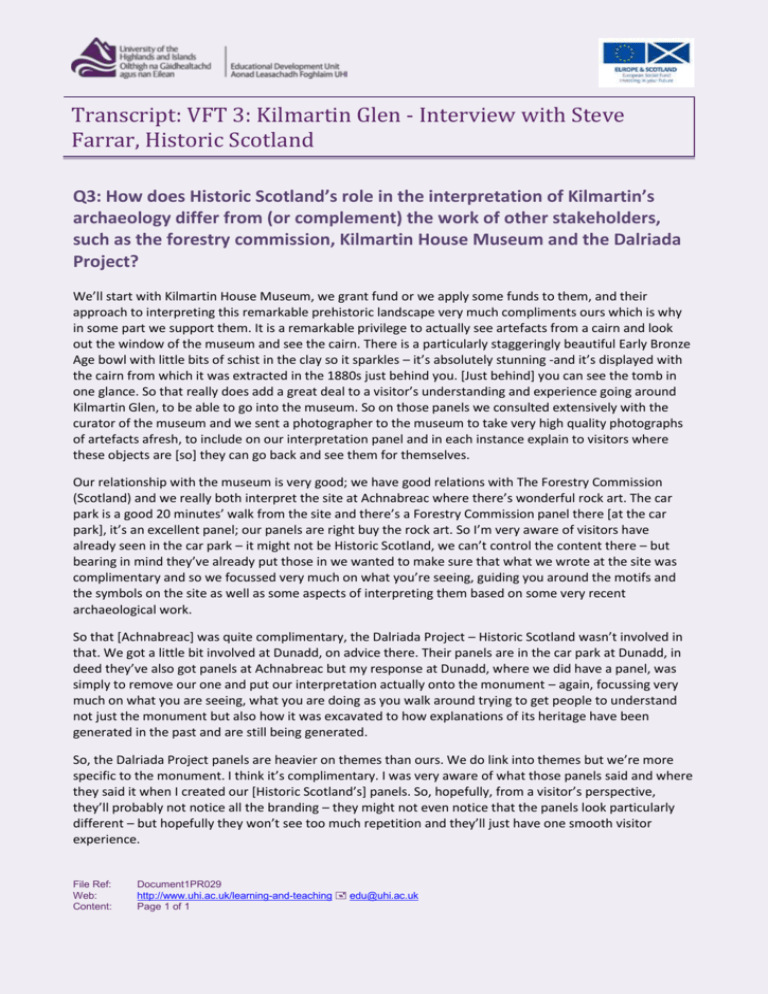
Transcript: VFT 3: Kilmartin Glen - Interview with Steve Farrar, Historic Scotland Q3: How does Historic Scotland’s role in the interpretation of Kilmartin’s archaeology differ from (or complement) the work of other stakeholders, such as the forestry commission, Kilmartin House Museum and the Dalriada Project? We’ll start with Kilmartin House Museum, we grant fund or we apply some funds to them, and their approach to interpreting this remarkable prehistoric landscape very much compliments ours which is why in some part we support them. It is a remarkable privilege to actually see artefacts from a cairn and look out the window of the museum and see the cairn. There is a particularly staggeringly beautiful Early Bronze Age bowl with little bits of schist in the clay so it sparkles – it’s absolutely stunning -and it’s displayed with the cairn from which it was extracted in the 1880s just behind you. [Just behind] you can see the tomb in one glance. So that really does add a great deal to a visitor’s understanding and experience going around Kilmartin Glen, to be able to go into the museum. So on those panels we consulted extensively with the curator of the museum and we sent a photographer to the museum to take very high quality photographs of artefacts afresh, to include on our interpretation panel and in each instance explain to visitors where these objects are [so] they can go back and see them for themselves. Our relationship with the museum is very good; we have good relations with The Forestry Commission (Scotland) and we really both interpret the site at Achnabreac where there’s wonderful rock art. The car park is a good 20 minutes’ walk from the site and there’s a Forestry Commission panel there [at the car park], it’s an excellent panel; our panels are right buy the rock art. So I’m very aware of visitors have already seen in the car park – it might not be Historic Scotland, we can’t control the content there – but bearing in mind they’ve already put those in we wanted to make sure that what we wrote at the site was complimentary and so we focussed very much on what you’re seeing, guiding you around the motifs and the symbols on the site as well as some aspects of interpreting them based on some very recent archaeological work. So that [Achnabreac] was quite complimentary, the Dalriada Project – Historic Scotland wasn’t involved in that. We got a little bit involved at Dunadd, on advice there. Their panels are in the car park at Dunadd, in deed they’ve also got panels at Achnabreac but my response at Dunadd, where we did have a panel, was simply to remove our one and put our interpretation actually onto the monument – again, focussing very much on what you are seeing, what you are doing as you walk around trying to get people to understand not just the monument but also how it was excavated to how explanations of its heritage have been generated in the past and are still being generated. So, the Dalriada Project panels are heavier on themes than ours. We do link into themes but we’re more specific to the monument. I think it’s complimentary. I was very aware of what those panels said and where they said it when I created our [Historic Scotland’s] panels. So, hopefully, from a visitor’s perspective, they’ll probably not notice all the branding – they might not even notice that the panels look particularly different – but hopefully they won’t see too much repetition and they’ll just have one smooth visitor experience. File Ref: Web: Content: Document1PR029 http://www.uhi.ac.uk/learning-and-teaching edu@uhi.ac.uk Page 1 of 1

